Adaptive Ranking of Web Pages
Ah Chung Tsoi
Office of Pro Vice-Chancellor(IT)
University of Wollongong
Wollongong, NSW 2522, Australia
Gianni Morini
Dipartimento di Ingegneria dell'Informazione
Universita' degli studi di Siena
Siena, Italy
Franco Scarselli
Dipartimento di Ingegneria dell'Informazione
Universita' degli studi di Siena
Siena, Italy
Markus Hagenbuchner
Office of Pro Vice-Chancellor (IT)
University of Wollongong
Wollongong, NSW 2522, Australia
Marco Maggini
Dipartimento di Ingegneria dell'Informazione
Universita' degli studi di Siena
Siena, Italy
Copyright
is held by the author/owner(s).
WWW2003, May 20-24, 2003, Budapest, Hungary.
ACM 1-58113-680-3/03/0005.
Abstract:
In this paper, we consider the possibility of altering the PageRank of web pages,
from an administrator's point of view, through the modification of the PageRank equation.
It is shown that this problem can be solved using the traditional quadratic programming techniques.
In addition, it is shown that the number of parameters can be reduced by clustering web pages
together through simple clustering techniques. This problem can be formulated and solved
using quadratic programming techniques. It is demonstrated experimentally on a relatively large
web data set, viz., the WT10G, that it is possible to modify the PageRanks of the web pages
through the proposed method using a set of linear constraints. It is also shown that
the PageRank of other pages may be affected; and
that the quality of the result depends on the clustering technique used.
It is shown that our results compared well with those obtained by a HITS based method.
Categories and Subject Descriptors
H.3.3 [Information storage and retrieval]: Information Search and Retrieval; H.5.4 [Information interfaces and presentation]: Hypertext/Hypermedia
General Terms
Search Engine, Page rank
Keywords
Adaptive PageRank determinations, Learning PageRank, quadratic programming applications
1. Introduction
Google is probably one of the most popular internet search engines available today. A major
feature of the Google search engine lies in its arrangement of the most ``relevant'' pages
with respect to a user's inquiry [
1]. This set of most ``relevant'' pages is obtained by what is
known as the PageRank algorithm [
2,
3,
4],
in which the web pages are ranked according to the
number of links which point to it.
A page with many links pointing to it
is highly authoritative. In [
2], an algorithm was given to
determine the PageRank of the web pages according to their link structures.
It is shown in [
2] that the PageRank of the set of web pages can be computed
using the following recursive algorithm:
 |
(1) |
where

is an

-dimensional vector denoting the PageRank of
the set of

web pages.

denotes the evolution of the PageRank vector at the

-th iteration.

is a

matrix with elements

if there is a hyperlink
from node

to node

, and

is the total number of outlinks of node

,
and

otherwise.

is an

-dimensional vector with all elements equal to 1.

is
a damping factor. The PageRank of the set of

web pages is given by the steady state
solution of (
1).
At the steady state, we have
 |
(2) |
Note that the PageRank of the set of web pages is determined once the link structure
among the web pages is given, and

fixed.
In other words, the PageRank of a set of web pages can be determined uniquely once the link structure of the web pages is fixed, and

is satisfied [
1,
3].
Note also that PageRank is only one among a number of factors which Google uses to
arrange the final score
![[*]](file:/usr/local/share/lib/latex2html/icons/footnote.png)
of a particular web page.
There are various attempts in altering the PageRank of a set of web pages.
There are two perspectives:
(a) from the perspective of users, and (b) from the perspective of web site administrators.
There is much discussion in the commercial literature on how to influence the PageRank of web pages
from a user's point of view. This is in recognition of the economic gain which might be
derived from having
highly ranked web pages,
as a human web surfer is mostly interested in the first few pages
of returned universal resource locators (URLs)
from the search engine query on a particular topic.
There are various techniques
deployed in the search engine optimization literature, mainly in changing the link structure
of web pages which are under the control of the user. As indicated previously, the link structure
is one of the factors which will determine the Google's score. Hence, by modifying the link topology,
paying special attention to the way that the PageRank is computed, it is possible to raise the
PageRank of selected pages under the control of the user. In addition, by exchanging links with
other users, it is possible to raise the PageRank of selected pages further.
From the web administrator's point of view, there are also reasons for raising or decreasing the PageRank
of certain web pages.
For example, if a user uses a ``link farm'' to artificially inflate their PageRanks, it would be useful if the web site administrator has a way to decrease the influence of the link farm mechanism in its determination of the PageRanks for other web pages.
In the case that the web site is used as a special purpose portal,
there may be situations in which the web site administrator would wish to increase the PageRank
of web pages which are related to the topics carried by the portal.
For example, the administrator of a portal on wine
may wish that pages about wine have a higher rank than other pages which are
unrelated to wine.
The administrator of a search engine may need to decrease the rank of spamming pages; or
the administrator of a site may wish that the energy
![[*]](file:/usr/local/share/lib/latex2html/icons/footnote.png)
of his/her site is higher than the energy of a competitor.
In this paper, we will consider possible modifications of PageRanks
from a web administrator's point of view. It is assumed that the web administrator has no
possibilities of modifying the topology of the link configuration of the web pages. The only
mechanism which is opened to the web administrator is to modify the PageRank equation (
1)
by modifying the ``control'' variable in that equation.
Consider the PageRank equation (
1). It is simple to note that this equation can
be written in more conventional notations as follows:
 |
(3) |
where

is a

dimensional vector, often called the state of the equation,

is a

dimensional vector, called the input vector.

is

constant matrix
and

is

constant matrix.
In the case of PageRank equation,

,

, the identity matrix,

, and

has all
elements equal to

. Thus, the issue here is how to design the control variable

in such a way that the PageRanks of a set of selected web pages are altered.
There are two ways in which we can modify the PageRank by manipulating the control variable

:
- Dynamic control. In this case, the issue is to design a set of controls
 ,
,
 such that the PageRanks is modified (when they reach the steady state).
such that the PageRanks is modified (when they reach the steady state).
- Static control. In this case, recognizing the fact that the PageRank is the steady state
solution of (1), it might be possible to design
 in such a way that the PageRanks of selected web pages are modified.
in such a way that the PageRanks of selected web pages are modified.
In this paper, we will only consider the simpler case of static control design,
rather than the more difficult dynamic control design.
Thus the problem we wish to address in this paper is: given a set of PageRanks of selected web pages
obtained from the steady state solution of (
2), is
it possible to modify this set of PageRanks by
designing a set of controls.
This question as it stands is ill-posed in that we need a criterion to determine the nature of the
control variables used and the nature of constraints in which we wish to place on the
modified PageRanks. Let us denote the set of PageRanks given by (
2) as

,
where

denotes that this is the PageRank as obtained by using Google's PageRank
equation. In subsection
1.1, we will first consider the type of constraints which
may be placed on the original PageRanks, while in subsection
1.2, we will consider the
cost criterion which can be placed on the system to obtain a solution.
1.1 The constraints
In the simplest case, the ranks of
selected pages are set to predefined target values. For
example, the administrator of a search engine may notice that a page is ranked lower
than desired and
may decide to increase its rank by

. Thus, the
target for that page will be the original rank times

.
Formally, let us assume that pages

have the targets

,
respectively, whereas the ranks of other pages are undefined. The constraint
can be written as follows:
 |
(4) |
where
![$\mbox{\boldmath$Y$}^{'}=[y_1 ,\ldots, y_t]$](820-tsoiimg44.png)
, the superscript

denotes the transpose of a vector, or a matrix,
and

is a projection matrix such that
![$S\mbox{\boldmath$X$}=[x_{i_1} ,\ldots, x_{i_t}]$](820-tsoiimg47.png)
.
In other cases, one may wish to establish an ordering on the pages. For example,
we can enforce

by the inequality

, where
![$\mbox{\boldmath$V$}=[v_1,\ldots, v_n]$](820-tsoiimg50.png)
,

and

. Similarly, one can constrain the energy
of the site to be larger than a threshold

, by the inequality

.
More generally, a set of

rules on the PageRanks can be formally defined as follows:
 |
(5) |
where

and

. These rules can constrain the ordering
between two pages; they can enforce the ordering between the energy of two communities;
they can establish a range of desired values for the rank of a page and so on.
Most likely administrators have no a priori information concerning the
range of PageRanks of vector

; therefore
a common constraint will be to deal with the order of the pages, rather than the PageRanks.
For example, if our set of pages consists of

and
we wish that the rank

be more important than

, it seems natural to write
where

is a coefficient chosen by the administrator.
The following example shows that such a constraint does not necessarily ensure the desired result:
where

is the absolute
position induced by the rank.
In order to avoid this problem, we need to enforce the rank of each page
involved in the constraints to be positive.
In our example the set of constraints will be:
Hence, an additional constraint on the variables is that the state variables

for which
the constraints are satisfied must satisfy further that

.
1.2 Cost
It is reasonable to adopt the following assumption: apart from the web pages whose PageRanks
need to be modified, for the rest of web pages in the web site, we do not wish to perturb their
current rank if possible.
Let

be the PageRank of a set of web pages as obtained from (
2). Let

be the
modified PageRanks the same set of web pages when we apply the control. Then, it is reasonable
to expect that the following cost function can be imposed:
 |
(6) |
where

denotes the

-norm of the set of vectors,

.
In this paper, we will only consider
the case where

.
The problem of modifying the PageRank can be posed as follows:
 |
(7) |
where

is an

dimensional vector, denoting the
set of control variables, subject to the constraints:
The structure of the paper is as follows: In Section
2, we will first consider
a solution of the problem at hand. In Section
3, we will show how this solution
can be modified to solve the more general case. In Section
4, we will
show how the constraints can be relaxed. In Section
5, we will present
a set of experimental results designed to verify the behaviour of the proposed algorithm, and
to show what types of solutions are possible.
Conclusions are drawn in Section
6.
2. First solution
Since the PageRank is obtained as the steady state solution of (
1),
it is reasonable to infer that we will only be interested in the steady state solution
of (
8). Towards this end, if we define
 |
(10) |
then we can write the solution of (
8) as
 |
(11) |
which is the same as PageRank except for the vector

in place of

.
We can substitute (
11) in (
9) to obtain
 |
(12) |
Now we can consider the cost function

as follows:
where the constant term

can be omitted in the minimization of the function
 |
(14) |
Finally, we can use (
14) as cost function in
 |
(15) |
Notice that (
15) is a standard positive definite quadratic programming
problem with an inequality constraint set which can be solved
very efficiently
[
5]. The problem fits in
the positive definite quadratic programming problem because

is positive definite with
an inequality constraint set.
The solvability of this problem is given as follows:
 is positive definite. In this case, it is satisfied.
is positive definite. In this case, it is satisfied.
-
 , and
, and
 , where the superscript
, where the superscript  denotes the
optimal solution and
denotes the
optimal solution and  denotes the reduced matrix
denotes the reduced matrix  which contains only
which contains only  rows
in which the constraints are satisfied, assuming that there are only
rows
in which the constraints are satisfied, assuming that there are only  constraints which are active.
constraints which are active.
-
 , where
, where  is the set of Lagrange multipliers,
and
is the set of Lagrange multipliers,
and
 ,
,
 .
.
Later, in Section
4, we introduce a method to compute a sub-optimal solution
when the constraints in (
15) do not have feasible solutions.
3. Practical solution
For the world wide web,

, the dimension of the PageRank equation, or the modified PageRank
equation can be in the region of billions. Hence it would not be possible to solve the quadratic
programming problem formulated in Section
2, apart from some very simple problems of which

is of low order.
In this section, we will introduce a practical method for solving the situation when

is large.
The key is to group pages in the world wide web together into clusters, and thus reducing the
number of dimension of the state space which needs to be considered.
3.1 Reduce the complexity
Let us consider a partition

of web pages. In other words, we wish to partition
the total number of web pages into

clusters. These clusters can be arranged
according to some criteria, e.g., approximately the same PageRank, approximately the same score.
For sake of simplicity, we further assume that
the pages are ordered so that the pages in cluster

are

,
the pages in cluster

are

and so on.
In our approach, the vector

is defined by

parameters (control variables),
one parameter for each cluster. The main reason why we use this
technique is that the number of control variables in the modified PageRank equation is
the same as the number of states. Hence, if the number of states is reduced through clustering from

to

, then the corresponding number of control variables is reduced as well.
More precisely, we have
 |
(16) |
Intuitively, the parameter

controls the a priori rank given to pages of class

.
This method will determine the a priori rank in order to satisfy
the constraint (
4) and/or (
9). In this way, we consider
that the pages are grouped into classes. Thus, for example, increasing the rank
of a page about wine will probably produce also an increase in the rank
of other pages about wine
![[*]](file:/usr/local/share/lib/latex2html/icons/footnote.png)
.
Moreover, the method gives consideration to
the connectivity (the connection topology) of the web pages, since
whereas the parameters

control the a priori rank given to the web pages, the constraints control the
final rank

of these web pages. For example, the algorithm increases the
rank of pages on wine may also increase the rank of their parent pages

,
e.g. the pages on cooking.
Let

be the columns of

. Note that
where

,

, are the vectors obtained by summing
all the columns

that correspond to the class

.
We define further:
![\begin{displaymath}
A=[\mbox{\boldmath$A$}_1,\ldots,\mbox{\boldmath$A$}_k ]
\hsp...
...}{c}e_1 \\ e_2 \\ \vdots \\ e_k \end{array}\right)\hspace{1cm}
\end{displaymath}](820-tsoiimg132.png) |
(17) |
Thus, we can write

which allows us to rewrite (
12) as follows:
 |
(18) |
where

.
Moreover, note that the vectors

fulfill
where
![$\mbox{\boldmath$O$}_i=[0,\ldots, 0, 1,\ldots, 1, 0,\ldots, 0]$](820-tsoiimg137.png)
is the
vector where the

-th component is

if

-th page belongs to

-th class and

, otherwise. Thus, the vectors

can be easily
computed, using the same approach adopted
for PageRank, by
 |
(19) |
Let us define the clustering matrix
![\begin{displaymath}
U=[\mbox{\boldmath$O$}_1,\mbox{\boldmath$O$}_2,\ldots,\mbox{\boldmath$O$}_k]
\end{displaymath}](820-tsoiimg139.png) |
(20) |
We can use

in the following equation:
 |
(21) |
Since

,
so we can write

.
Now we can focus on the cost function (
14). We
use (
21) to write:
In the following, we use

for the quadratic term and

for the linear term in the cost function
 |
(22) |
Consequently, in order to find the optimal solution

, we proceed to solve
the quadratic programming problem
![[*]](file:/usr/local/share/lib/latex2html/icons/footnote.png)
 |
(23) |
Note that

, where the number of constraints

and the number of
clusters

is small, and

.
4. Relaxed Constraints Problem
In the event that administrators define contradicting
constraints then (
23) has no feasible solutions.
In order to compute a sub-optimal solution, we introduce a method to regulate the strength of the constraints.
Instead of forcing the algorithm to fulfill the constraints, we add a new term to the cost function:
 |
(24) |
where the coefficient
![$s\in [0,1]$](820-tsoiimg157.png)
is used
to balance the importance between constraints and the original cost function.
We wish to express (
24) in a standard quadratic programming formulation.
We first focus on the second term in (
24)
Notice that we can remove the constant term

without affecting the solution. We can substitute in (
24)
Let us define
 |
(25) |
 |
(26) |
Matrix

is positive semi-definite as well and we can finally write (
24) in the following manner:
 |
(27) |
This approach allows us to find a sub-optimal solution for every constraint set.
The parameter

influences the resulting rank vector

in the following manner:
4.1 Remarks
Our proposed method can be summarized as
follows:
- Step 1
- Use a clustering algorithm in order to split the pages of the Web into clusters
 .
.
- Step 2
- Compute the
 by solving the related
by solving the related  system defined by (19).
system defined by (19).
- Step 3
- If (9) has a feasible solution, solve the quadratic programming
problem (23) in order to compute the optimal set of parameters

- Step 4
- If (9) has no feasible solutions, solve the quadratic programming
problem (27) to compute a sub-optimal set of parameters
 .
.
- Step 5
- Compute the rank as

The complexity of the algorithm is determined by steps 1-3. The computational
cost of the clustering technique depends on the adopted clustering method. The cost of step 2
is

times the cost of that of the computation of PageRank. Step 3 requires to find a solution
of a quadratic programming problem in

variables and

constraints. Provided that the
number of constraints

and the number of classes

are not large, the problem can be solved in a
reasonable time.
Note that the above algorithm works also if we use (
4) instead of (
9).
Moreover, the method can be extended to the case when the clustering algorithm
produces one or more classes for each page. In fact, let
![$L(p)=[c_1^p,\ldots,c_k^p]$](820-tsoiimg172.png)
be
a vector, where

measures the probability that page

belongs to class

.
Let

be the vector
![$[c_i^1, \ldots, c_i^n]$](820-tsoiimg175.png)
that represents how much each
page belongs to class

.
We can consider the following dynamic system
where

are parameters that
can be computed using the previously adopted reasoning. In this case,

will be calculated by
5. Experiments
For the experiments conducted in this section we use a subset of the WT10G
data set, as distributed by CSIRO in Australia.
It pays special attention to the connectivity among the web pages. Hence this
set of web collection is suitable for evaluations of search engine algorithms based on
connectivity concepts, e.g., PageRank method.
Some of the properties of WT10G dataset are as follows:
- 1,692,096 documents from 11,680 servers.
- 171,740 inter-server links (within dataset)
- 9,977 servers with inter-server in-links (within dataset)
- 8,999 servers with inter-server out-links (within dataset)
- 1,295,841 documents with out-links (within dataset)
- 1,532,012 documents with in-links (within dataset)
Instead of using the entire WT10G data set, we have chosen to use a subset comprising
150,000 documents. Such a subset is sufficiently large to evaluate our proposed algorithm
while reducing the time needed to conduct individual experiments and hence, allowing
a reasonable turn round time of tasks.
In this section we wish to investigate the following issues:
- Is the proposed algorithm effective in rearranging the pages as desired?
- How does the application of constraints on some pages affect the ranking of other pages in the collection?
- The effects of the number of clusters on the performance of the algorithm.
- The effect of clustering methods on the performance of the algorithm.
It is possible to combine tasks (1) and (2) since the answer to (2) allows the drawing of conclusions on (1).
Experimental results are summarized in the following subsections.
5.1 Constraints effect
For this initial set of experiments
we chose to cluster the pages into 15 equally sized clusters.
The clusters are formed by sorting the pages according to their PageRanks in
descending order as shown in Figure
1.
Figure 1:
Rank distribution in the subset of the web collection with 150,000 pages.
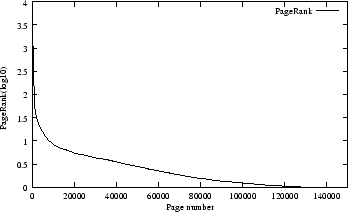 |
The

highest ranked pages are assigned to the first cluster.
From the remaining set of pages we assign the next

highest ranking pages to cluster2, and so on.
In order to simplify the evaluation, we consider only
one type of
constraints, viz., to swap the importance of two pages located at a distance

apart.
Our aim is to find the effectiveness of the proposed algorithm, and to
understand the influence of a single constraint on the page order of the rest of the web collection.
Thus, we consider a page

with absolute position

and page

with absolute position

,
and impose a constraint as follows:
We give results from using

, and

.
For example,

implies that the task is to swap the position of the
10-th page with the page located at position

relative to PageRank.
Results are presented in Figures
2 to
5.
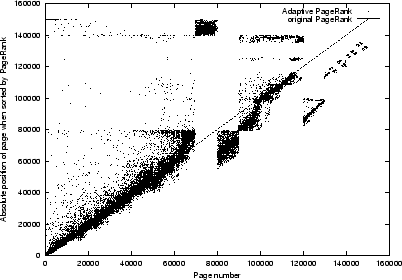
Figure 2:
Test of the change in absolute position (abspos) with a single constraint ( and
and  ). The y-axis represents the absolute position of a page (when sorted by rank in a descending order), the x-axis gives the original order of the web pages ranked by Google's PageRank method. A data point located at the diagonal indicates that the rank is unchanged. The number of clusters is fixed at 15.
). The y-axis represents the absolute position of a page (when sorted by rank in a descending order), the x-axis gives the original order of the web pages ranked by Google's PageRank method. A data point located at the diagonal indicates that the rank is unchanged. The number of clusters is fixed at 15.
| |
Page-ID |
| PageRank |
Adaptive Rank |
| |
| |
WTX00... |
| rank |
| abspos |
rank |
| abspos |
| | | | 946.3 |
| 10 |
14.25 |
| 868 |
| | | | 54.49 |
| 1010 |
14.66 |
| 840 |
| |
Std. deviation of page pos. changes = 22921.9 |
|
| |
|
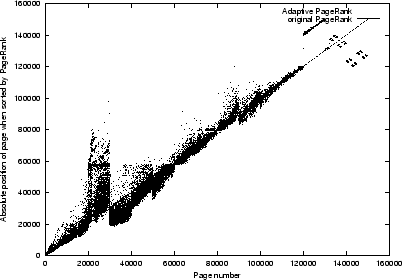
Figure 3:
Test of the change in absolute position with a
single constraint ( and
and  ). The y-axis represents
the absolute position of a page (when sorted by rank in a descending order),
the x-axis gives the original order of the web pages ranked by Google's PageRank method.
The number of clusters is 15.
). The y-axis represents
the absolute position of a page (when sorted by rank in a descending order),
the x-axis gives the original order of the web pages ranked by Google's PageRank method.
The number of clusters is 15.
| |
Page-ID |
| PageRank |
Adaptive Rank |
| |
| |
WTX00... |
| rank |
| abspos |
rank |
| abspos |
| | | | 54.92 |
| 1000 |
8.99 |
| 1765 |
| | | | 31.66 |
| 2000 |
9.13 |
| 1731 |
| |
Std. deviation of page pos. changes = 10665.1 |
|
| |
|
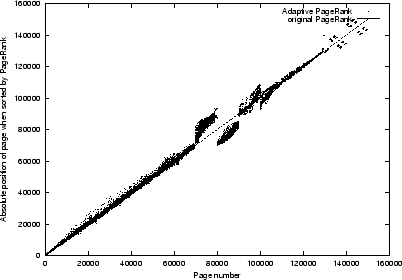
Figure 4:
Test of the change in absolute position with a
single constraint ( and
and  ). The y-axis represents
the absolute position of a page (when sorted by rank in a descending order),
the x-axis gives the original order of the web pages ranked by Google's PageRank method.
The number of clusters is 15.
). The y-axis represents
the absolute position of a page (when sorted by rank in a descending order),
the x-axis gives the original order of the web pages ranked by Google's PageRank method.
The number of clusters is 15.
| |
Page-ID |
| PageRank |
Adaptive Rank |
| |
| |
WTX00... |
| rank |
| abspos |
rank |
| abspos |
| | | | 15.40 |
| 5000 |
3.52 |
| 5873 |
| | | | 12.97 |
| 6000 |
3.51 |
| 5898 |
| |
Std. deviation of page pos. changes = 3932.1 |
|
| |
|
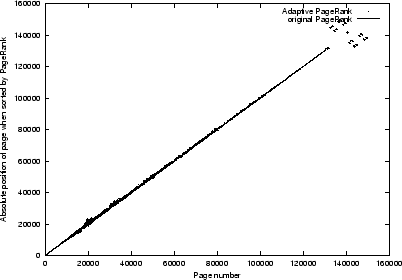
Figure 5:
Test of the change in absolute position with a
single constraint ( and
and  ). The y-axis represents
the absolute position of a page (when sorted by rank in a descending order),
the x-axis gives the original order of the web pages ranked by Google's PageRank method.
The number of clusters is 15.
). The y-axis represents
the absolute position of a page (when sorted by rank in a descending order),
the x-axis gives the original order of the web pages ranked by Google's PageRank method.
The number of clusters is 15.
| |
Page-ID |
| PageRank |
Adaptive Rank |
| |
| |
WTX00... |
| rank |
| abspos |
rank |
| abspos |
| | | | 5.51 |
| 20000 |
1.38 |
| 22452 |
| | | | 5.35 |
| 21000 |
1.38 |
| 22439 |
| |
Std. deviation of page pos. changes = 3260.1 |
|
| |
|
From Figures
2 to
5 we draw the following observations:
- The proposed algorithm is effective in modifying the PageRank as desired.
- It is observed that a constraint on highly ranked pages disturbs the PageRank
of the rest of the web collection more significantly. For example, for
 ,
it is observed that the standard deviation of the PageRank is
,
it is observed that the standard deviation of the PageRank is  as compared to
as compared to  when
when  .
.
- It is noted that the perturbations of the pages appear in blocks. We found that this
is due to the clustering of the web pages. Pages belonging to a cluster are bound together
by the same parameter. This finding implies that the quality of the result is influenced
by the number of clusters used.
- It is observed that when swapping the positions of two pages,
the effect on lower ranked pages is stronger than on higher ranked pages.
- The observation that the location of higher ranked pages are perturbed by applying
constraints on lower ranked pages
can be explained by the fact that lowly ranked pages can have parents which are
highly ranked. Hence, if we perturb the rank of the lowly ranked pages, then this
can have an effect on parent pages which might be ranked higher. In other words, if we perturb
the PageRanks of web pages, then we will perturb their associated ancestors as well.
The extent to which the perturbation manifests itself depends on the original rank of the pages affected.
Further explanations of the results can be drawn by considering the distribution of the
original PageRanks
(Figure
1).
From Figure
1 we find that only a small percentage of
the pages have significant ranks.
Thus, if the ranks are perturbed, it may be conceivable that
the ranks of the perturbed pages are such that it takes very little effort for them to be
different from the original ranks. In other words, the wide ranging perturbation observed in
Figure
2 and Figure
3 may be due to the fact that there is not much difference
in the ranks among the web pages in the mid-range and the end of the range of the distribution of ranks
as shown in Figure
1. This explanation might be particularly appropriate to explain
the relatively wildly perturbed ranks towards the end of the spectrum, e.g., in the range when
the original ranks are between 120,000 and 150,000. From Figure
1, it is observed
that the ranks of these pages are almost 1 (

as shown in the Figure),
hence if they are perturbed, then it is easily conceivable that their relative positions
may alter relatively wildly while the actual rank values change little.
The findings in this section suggest that the quality of the results is influenced by
the number of clusters chosen. The effect of this parameter is investigated next.
We investigate the influence of the number of clusters which were introduced to reduce the complexity.
We conduct experiments that gradually increase the number of clusters used from
5 to a maximum of 100 clusters. The effect is evaluated by considering the cost
function, and the standard deviation of the absolute position as a measure.
The result is given by Figure
6.
Figure 6:
Evaluate the behaviour of the proposed algorithm as a function of the number of clusters.
The graph on the top shows the variation of the standard deviation of the absolute position,
while the graph on the bottom shows the variation of the cost function as a function of the number of clusters.
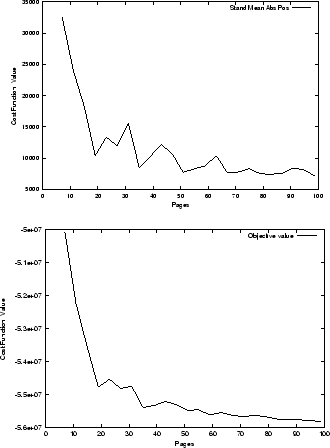 |
It is observed that the cost function decreases with the number of clusters
used, leveling out at around 60 clusters. Thus, it can be concluded that for
the given data set, the cost function does not improve significantly even if we
increase the
number of clusters beyond 60. The standard deviation of the
absolute position as a function of the variation of the number of clusters shows a similar behaviour.
The experiments confirmed that:
- It is possible to reduce the level of complexity of the algorithm by using the idea of clustering.
- The number of clusters may be quite small in comparison with the total number of web pages in the collection.
Each of these experiments required only minutes to execute on a dual headed Xeon-2GHz environment with 4 GB RAM; specifically, 2 minutes were required when using 15 clusters, and 7 minutes when using 50 clusters.
A number of ways in which web pages can be clustered are considered in the following:
- (a) Clustering by score
- This simple method uses a classifier to assign a coefficient
of affinity about a specific topic to each page in the web graph.
We refer to this coefficient as the score
 for the page
for the page  .
Given a fixed number of cluster
.
Given a fixed number of cluster  , we compute the
score range
, we compute the
score range
A page  belongs to cluster
belongs to cluster  if
if
 .
An effect is that clusters will be of different size. The dimension of each cluster depends on the distribution of the score in the graph.
.
An effect is that clusters will be of different size. The dimension of each cluster depends on the distribution of the score in the graph.
- (b) Clustering by rank
- This method suggests to use the PageRank as computed in (2).
Given a fixed number of clusters
 we compute the
rank range
we compute the
rank range
A page  belongs to cluster
belongs to cluster  if
if
 .
The dimension of each cluster depends on the distribution of the rank in the web graph.
.
The dimension of each cluster depends on the distribution of the rank in the web graph.
- (c) Clustering by rank with fixed cluster dimensions
- The dimension of each cluster can be fixed to
 , where
, where  is the dimension of the web graph.
This is done by ordering the pages of the graph according to the rank as
computed in (2), and assign the first
is the dimension of the web graph.
This is done by ordering the pages of the graph according to the rank as
computed in (2), and assign the first  pages to the cluster
pages to the cluster
 , the second set of
, the second set of  pages to the cluster
pages to the cluster  and so on.
This clustering method was used for the experiments shown earlier in this section.
and so on.
This clustering method was used for the experiments shown earlier in this section.
- (d) Clustering by rank
- with variable cluster dimensions using a set regime
The idea of this method is motivated by observations made on experimental findings made earlier.
The idea is to treat highly ranked pages differently
because they play a critical role. The size of the cluster is to be smaller
for clusters that contain more relevant pages, while we can tolerate larger
dimensions for clusters that contain relatively irrelevant pages.
We define a coefficient
 and a multiplication factor
and a multiplication factor  . We order the pages of the web
graph according to the
rank as computed in (2) and we assign the first
. We order the pages of the web
graph according to the
rank as computed in (2) and we assign the first  pages to the cluster
pages to the cluster  , the second set of
, the second set of  pages to the cluster
pages to the cluster  and so on.
For example, for
and so on.
For example, for  and
and  the resulting cluster dimensions will be
the resulting cluster dimensions will be

Some of these clustering techniques were tried in experiments where the result is
given in Figure
8.
Case (b) was not attempted as this case is approximated by case (d).
For the case where we cluster by score using variable dimensions the cluster sizes
are as shown in Figure
7.
Figure 7:
The distribution of web pages in the clustering by scores using variable dimension method.
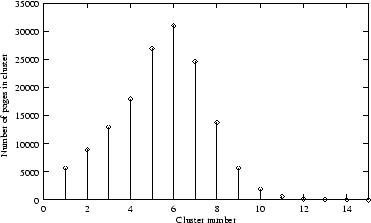 |
The constraint used in this experiment is to swap the position of two web pages located at 1000 and 2000.
Std. deviation: 27797.1
Std. deviation: 24668.7
Std. deviation: 3619.31
Figure 8:
Results of experiments on the effects of
various clustering methods on the performance of the proposed algorithm.
The upper plot uses clustering by score with variable dimension, the center plot uses
clustering by scores with fixed dimension. The lowest plot gives
a graph using clustering by rank with variable dimensions using a set regime.
The clustering by rank with fixed dimensions was shown in Figure 3
|
From Figure
7 it is observed that:
- The clustering scheme has a significant influence on the quality of the result.
- To build clusters from page scores generally produces the worst performance
in terms of the perturbation on the PageRanks.
- Clustering methods based on rank gives good results.
- The clustering by ranks using a variable dimension
by considering the magnitude of the PageRank
appears to be working best.
In this experiment, we investigate the effect of a constraint that involves
pages belonging to the same site
![[*]](file:/usr/local/share/lib/latex2html/icons/footnote.png)
. The question which we like to answer is:
are the changes in the absolute position of the web pages caused by the proposed algorithm
primarily affect pages from within the same community? In other words,
could the changes in the PageRanks mostly come from the same community. This is
quite a reasonable hypothesis in that if we wish to swap two pages in the
same community, then most of the changes in the PageRanks might come from the
same community, and only to a lesser extent come from other web pages un-related
to the community.
We carry out an experiment to evaluate this proposition. We chose a community
``Stanford University''. In our web collection of 150,000 web pages we found
105 web pages which are from the Stanford community.
In order to minimize the effect of clustering, we use 50 clusters, where each cluster is of
dimension 2000. The constraint is to swap the position of two pages from the Stanford
community, one located at (absolute) position 4377, and the other located at absolute
position 6246. The results of the experiment are shown in Figure
9.
Figure 9:
Results of restricting the perturbed web pages to the same community. The graph on top
shows the change in absolute positions of web pages related to the community. The bottom
graph shows the change in absolute positions relative to all web pages in the collection.
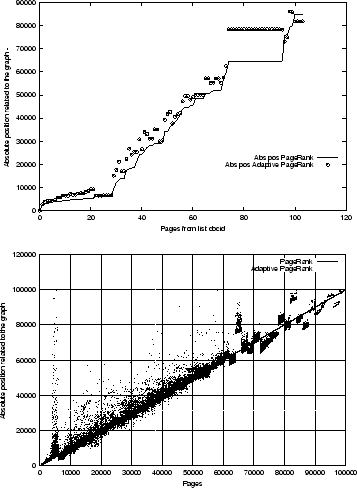 |
From Figure
9, it is observed that the perturbation of the web pages is not restricted to
within a site to which a constraint was placed.
Also, we did not observe that the perturbation
within a site is more violent than on pages external to the site.
This result can be understood by the fact that even though the Stanford community has
many connections among themselves, nevertheless, the web pages are connected to links outside
the community. By swapping the ranking of two web pages within the community, it also affects
the relative ranking of those web pages external to the community. Hence, it is not surprising
to see that the PageRanks of web pages external to the community also change.
To the best of our knowledge, the only alternative approach to alter the ranking of web pages
from an administrator's point of view has been suggested by Chang etal.[
6].
The underlying idea is to extend Kleinberg's HITS algorithm [
7] by altering
the eigenvector such that a given target page is given more weight. This is performed
by using a gradient descent method on the elements of the link matrix

. Chang etal.
[
6] indicated that their algorithm not only increases the rank of a given
page but also increases the rank of all pages that are similar to the given page.
A set of experiments was conducted to allow a qualitative comparison of our
proposed algorithm with that proposed in [
6]. The first striking difference of
the two algorithms is the computational complexity. Chang et al.'s algorithm relies on a
recursively applied multiplication of link matrices which resulted in non-sparse matrices.
As a consequence, it is unlikely that Chang et al.'s algorithm is able to process link matrices
which arise from the live world wide web. In practice, we found that we were unable to
execute experiments for

on a dual Xeon-2GHz system equipped with 4GB
of memory due to memory requirements. In actual fact we had to reduce

even further to allow experiments to be executed within a reasonable amount of time.
Figure 10:
Comparing Changetal.'s algorithm (left) with our algorithm (right). Rising the rank of page at absolute position 1000 (top row), 2000 (center), and 4000 (bottom). Sub-sets are of size 4000 (top), 7000 (center), and 10,000(bottom)
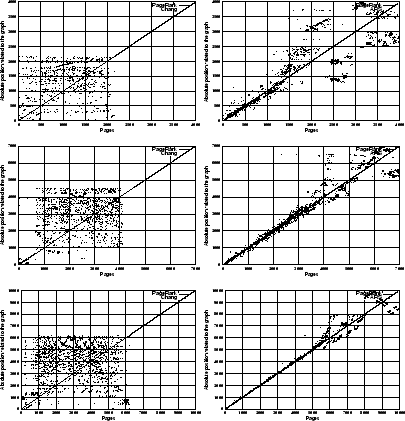 |
We executed the algorithm using sub-sets of size 4000, 7000, and 10,000, and employed training parameters as suggested in [
6]. Results
are then compared with those obtained by using our algorithm. The result is given in
Figure
10. We found that the algorithm in [
6] provides an
effective method for raising (or lowering) the rank of a given document. However, we also found
that other pages which are considered to be `similar' also rose by rank. This `similarity',
however, is related to the number of inlinks and outlinks rather than to the actual content of
a page. Secondly, Chang et al.'s algorithm is not effective for pages which have no inlinks
(from within the training set). These pages are generally ranked lowest.
In Figure
10 (top left graph), it is observed that only the first 2150
pages feature inlinks
![[*]](file:/usr/local/share/lib/latex2html/icons/footnote.png)
. Hence only pages that are ranked high are affected.
A further observation was that an experiment required 18 hours for a sub-set of size 4000, and 48 hours for a sub-set of 10,000 pages on the Xeon-2GHz to complete whereas our proposed algorithm completed each run within a few seconds.
Overall, the algorithm in [
6] is a simple method which is effective in
altering the rank of a given web page from within a limited set of pages. The degree to
which a given page is affected cannot be set, nor does the algorithm allow to limit the
effect on other pages. In contrast, our proposed algorithm can incorporate these constraints transparently.
6. Conclusions
In this paper, we first consider the possibility of modifying the ranking of web pages belonging
to a web collection by allowing the design of a set of control variables. We formulate
the problem as a standard quadratic programming problem in minimizing a cost function which
is the deviation of the absolute position of the web pages after being processed
by the proposed algorithm, and that of the original ranking as given by Google's PageRank algorithm,
subject to a number of constraints. Then we carry out a set of experiments designed to
evaluate the validity and understand the behaviours of our proposed algorithm.
It is found that it is possible to find a solution to the given task. In addition,
it is found that the PageRanks of all web pages are affected when placing a constraint on some of the web pages.
The effect on the global PageRanks depends on the rank of the pages to which a constraint is applied,
and on the clustering method chosen. If these pages are located in the relatively high ranking range,
then the PageRanks of the web pages will be perturbed more violently. On the other hand, even if
constraint affected pages are located in the relatively low rank region, it is observed that
higher ranked pages may also be perturbed. This is explained by the fact that these highly ranked pages
are the ancestors of the lowly ranked pages. Hence by altering the PageRanks of the lowly
ranked pages, it is possible that the ancestors of these lowly ranked pages would need to be
perturbed as well. The effect of PageRank perturbation is minimized by choosing a sufficiently
large number of clusters, where the clusters are formed with respect to
the magnitude of the rank of pages. Also, moderate constraints placed on lower ranked
pages significantly reduce PageRank perturbations.
An issue which we have not addressed in this paper is the nonlinear relationship between
rank and position. This is best illustrated as follows:
Ideally we do not wish to perturb the order

of the web
pages induced by the function

applied on the rank vector

computed in (
2) (see example in Figure (
11).
Figure 11:
Example of order
 induced by
induced by
 .
.
 |
The function

is highly nonlinear. Because this mapping function is highly nonlinear,
it could happen that while the constraints on the web pages are satisfied, the absolute position
of the resulting web pages could be worse off. For example, if we wish to swap the position
of two web pages located in position

and

, and

. After we process this using the proposed algorithm,
the two pages are located in positions

and

respectively, with

. It could happen that

. In other words, the overall positions of the two swapped pages are worse off
than before the modification. This seems to defeat the purpose of the modification,
in that we wish to improve the position of particular web pages, with respect to
others. Thus, it would be useful to have an algorithm which will preserve the absolute position of the
designated web pages.
Secondly, in our experiments we have only considered a single constraint, viz., to swap
the position of two designated web pages. We could have imposed more constraints.
However, the picture is more complex, as it would be difficult to draw conclusions on
observations on experimental results. It would be useful if there is a more systematic method
for finding out the effects of multiple constraints on the modification of PageRanks.
These tasks are presented as a challenge for future research.
- 1
- Bianchini, M., Gori, M., Scarselli, F. ``Inside PageRank'', Tech. Report DII 1/2003, University of Siena, Italy, 2003.
- 2
- Brin, S., Page, L. ``The anatomy of a large scale hypertextual web search engine''. Proceedings of the 7th WWW conference, April, 1998.
- 3
- Ng, A.Y., Zheng, A.X., Jordan, M.I. ``Stable algorithms for link analysis'', in Proceedings of IJCAI-2001, 2001.
- 4
- Zhang, D., Dong, Y. ``An efficient algorithm to rank web resources'', in Proceedings of the 9th WWW Conference, Elsevier Science, 2000.
- 5
- Gill, P., Murray, W., Wright, M., Practical Optimization. Academic Press, 1981.
- 6
- Chang, H., Cohn, D., McCallum, A.K., ``Learning to Create Customized Authority Lists'', Proc. 17th International Conf. on Machine Learning, 2000.
- 7
- Kleinberg, J., ``Authoritative sources in a hyperlinked environment'', Proc. 9th ACM-SIAM Symposium on Discrete Algorithms, 1998.
Adaptive Ranking of Web Pages
Converted by Latex2Html. The command line arguments were:
latex2html -nonavigation -noaddress -transparent -white -style http://www2003.org/www2003.css -prefix 820-tsoi -split 0 820-tsoi.tex
The translation was initiated by Markus Hagenbuchner on 2003-04-05
Footnotes
- ... score
![[*]](file:/usr/local/share/lib/latex2html/icons/footnote.png)
- In this paper, we make a distinction between ``PageRank''
and ``score''. PageRank is the value which is obtained from the steady state solution of
(1), while score is the final value which is obtained by taking into
account a number of other factors, e.g., the anchor text, keywords, etc.
- ... energy
![[*]](file:/usr/local/share/lib/latex2html/icons/footnote.png)
- The sum of the PageRank of the
web pages in the site [1] as
a measure of the collective ``power'' of a set of web pages.
- ... wine
![[*]](file:/usr/local/share/lib/latex2html/icons/footnote.png)
- This is assuming that the clustering
method used is related to the content of the pages. This would not be true for
clustering methods based on other criteria, e.g., scores.
- ... problem
![[*]](file:/usr/local/share/lib/latex2html/icons/footnote.png)
- The standard quadratic programming formulation
for the function cost is
 where
where  is a
is a  symmetric matrix.
symmetric matrix.
- ... site
![[*]](file:/usr/local/share/lib/latex2html/icons/footnote.png)
- A site is a collection of pages
from the same domain (e.g. stanford.org).
- ... inlinks
![[*]](file:/usr/local/share/lib/latex2html/icons/footnote.png)
- The smaller the sub-set of web-pages, the less connectivity between pages, causing more pages to be isolated.
 ,
,
 such that the PageRanks is modified (when they reach the steady state).
such that the PageRanks is modified (when they reach the steady state).
 in such a way that the PageRanks of selected web pages are modified.
in such a way that the PageRanks of selected web pages are modified.
 ,
, .
. is positive definite. In this case, it is satisfied.
is positive definite. In this case, it is satisfied.
 , and
, and
 , where the superscript
, where the superscript  denotes the
optimal solution and
denotes the
optimal solution and  denotes the reduced matrix
denotes the reduced matrix  which contains only
which contains only  rows
in which the constraints are satisfied, assuming that there are only
rows
in which the constraints are satisfied, assuming that there are only  constraints which are active.
constraints which are active.
 , where
, where  is the set of Lagrange multipliers,
and
is the set of Lagrange multipliers,
and
 ,
,
 .
.



 .
. by solving the related
by solving the related  system defined by (19).
system defined by (19).
 .
.




 ,
it is observed that the standard deviation of the PageRank is
,
it is observed that the standard deviation of the PageRank is  as compared to
as compared to  when
when  .
.

 for the page
for the page  .
Given a fixed number of cluster
.
Given a fixed number of cluster  , we compute the
score range
, we compute the
score range

 belongs to cluster
belongs to cluster  if
if
 .
An effect is that clusters will be of different size. The dimension of each cluster depends on the distribution of the score in the graph.
.
An effect is that clusters will be of different size. The dimension of each cluster depends on the distribution of the score in the graph.
 we compute the
rank range
we compute the
rank range

 belongs to cluster
belongs to cluster  if
if
 .
The dimension of each cluster depends on the distribution of the rank in the web graph.
.
The dimension of each cluster depends on the distribution of the rank in the web graph.
 , where
, where  is the dimension of the web graph.
This is done by ordering the pages of the graph according to the rank as
computed in (2), and assign the first
is the dimension of the web graph.
This is done by ordering the pages of the graph according to the rank as
computed in (2), and assign the first  pages to the cluster
pages to the cluster
 , the second set of
, the second set of  pages to the cluster
pages to the cluster  and so on.
This clustering method was used for the experiments shown earlier in this section.
and so on.
This clustering method was used for the experiments shown earlier in this section.
 and a multiplication factor
and a multiplication factor  . We order the pages of the web
graph according to the
rank as computed in (2) and we assign the first
. We order the pages of the web
graph according to the
rank as computed in (2) and we assign the first  pages to the cluster
pages to the cluster  , the second set of
, the second set of  pages to the cluster
pages to the cluster  and so on.
For example, for
and so on.
For example, for  and
and  the resulting cluster dimensions will be
the resulting cluster dimensions will be


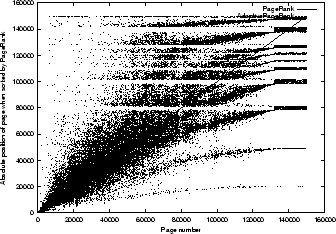
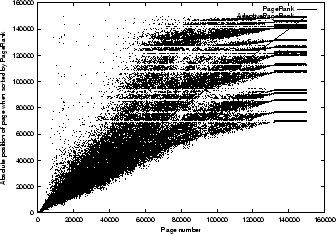
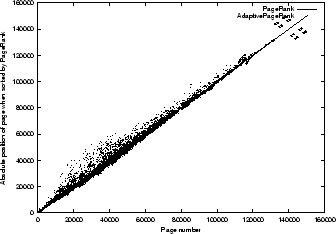


![[*]](file:/usr/local/share/lib/latex2html/icons/footnote.png)
![[*]](file:/usr/local/share/lib/latex2html/icons/footnote.png)
![[*]](file:/usr/local/share/lib/latex2html/icons/footnote.png)
![[*]](file:/usr/local/share/lib/latex2html/icons/footnote.png)
 where
where  is a
is a  symmetric matrix.
symmetric matrix.
![[*]](file:/usr/local/share/lib/latex2html/icons/footnote.png)
![[*]](file:/usr/local/share/lib/latex2html/icons/footnote.png)


![\begin{displaymath}
A=[\mbox{\boldmath$A$}_1,\ldots,\mbox{\boldmath$A$}_k ]
\hsp...
...}{c}e_1 \\ e_2 \\ \vdots \\ e_k \end{array}\right)\hspace{1cm}
\end{displaymath}](820-tsoiimg132.png)




